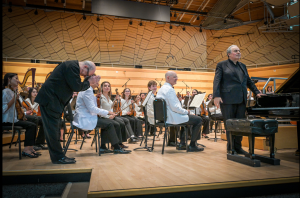Steiman: Beethoven concerto and ‘The Planets’ makes a worthy season finale

Diego Redel/Courtesy photo
The Aspen Music Festival’s final concert lived up to expectations Sunday afternoon. One of the biggest audiences of the season listened raptly as music director Robert Spano led the Festival Orchestra in a high-octane performance of Holst’s “The Planets” and a stellar traversal of Beethoven’s Emperor Concerto with pianist Yefim Bronfman.
Spano displayed his best conducting of the season, showing intensity and an eye toward the dramatic.
Paul-Boris Kertsman, the festival’s assistant conductor who teamed with Spano to conduct the singers in the world premiere of the opera “Siddhartha, She” and led other outstanding performances of contemporary music, got to do the opener. He drew robust sound and well-shaped phrasing in Wagner’s Prelude to “Die Meistersinger.”
The star of the show, though, was Bronfman. His legerdemain at the keyboard was in full display in the Beethoven, driving the tempo in the opening movement and softening the texture in the slow movement without losing the pulse. Dazzling with virtuosity in the many fast-moving gestures, always musically alert, the pianist shaped each phrase with just the right flair. Each of the many scales had a different shading, and the tinkly decorations Beethoven sprinkled liberally in lighter moments made me picture shimmering diamonds.
Known as a Beethoven master, Bronfman emphasized where emphasis was needed, and eased up when letting the music flow. Spano made sure the orchestra was on the same page, which made for an unforgettable performance all around.
“The Planets” was an intriguing choice for a big finale, with an enormous orchestra and plenty of exotic colors in the instrumentation. Even non-fans of classical music would recognize much of the music, which has been used for movies and television, even by rock bands. It’s been a while since I have heard a live performance of the whole thing, and let’s just say it stands the test of time.
Among the best moments were the dead-serious ponderousness of the first movement, “Mars, the Bringer of War” and the contrast with the deftly skittering “Mercury, the Winged Messenger.” I’ve always been partial to the fully fleshed out English character of “Jupiter, the Bringer of Jollity,” which darts between pub-like high spirits and the feverish ecstasy of a celebratory church festival day. It’s just jammed with great musical moments.
The orchestra caught the whimsy in the recurring six-beat rhythm for the bassoon melody in “Uranus, the Magician,” which struck me this time as a cousin to Dukas’s “Sorcerer’s Apprentice.” (Remember Mickey Mouse in “Fantasia”?)
The instrumental solos throughout were top-notch too, especially several limpid moments from concertmaster Alexander Kerr. Timpanists Edward Stephan and Will Howald executed their “duels” on multiple kettle drums with particular flair.
The final movement, “Neptune, the Mystic,” was the reason “The Planets” was chosen as the capstone of the season’s theme of spiritualism in music. It ends with a perfect musical portrayal of a planet deep in space, with a women’s chorus serenely fading out. In this case, the chorus was provided by a synthesizer. Opening and closing the door, as one might with a real chorus backstage, was effective.
Both of Saturday’s chamber music concerts benefited from pieces featuring cryptic dances. In their evening recital the Isidore Quartet had great fun with Schulhoff’s 1923 Five Pieces for String Quartet, in which the Prague-born composer created his own take on a Viennese waltz, an Italian serenata, a Czech dance, a tango and a tarantella.
Four of the members of the Isidore met as students at the festival’s school and formed the quartet six years ago. They play with uncanny uniformity, not just in tempo and pace but in tone and sheer sound, with a welcome sense of freewheeling through classical quartets. That paid off handsomely in the Schulhoff dances, which had the feel of making it up as they went along, only for it all to come together juicily. The waltz had an aggressive edge, and the tango came off as surprisingly spooky. The finale, a high-octane tarantella, raced to a lively climax.
This group showed a tendency to exaggerate the contrasts between the slow and fast sections, and softer and louder ones as well, of Haydn’s “Sunrise” Quartet. First violinist Adrian F. Steele’s eagerness to minimize vibrato created some wince-able moments but the menuetto was especially delicate. Much better was Dvořák’s G major quartet, in which the aforementioned exaggerations paid dividends in sheer excitement.
Leading off the afternoon’s chamber music, the Aspen Contemporary Ensemble offered perhaps their most accessible premiere of the summer. Christopher Stark’s “Prehistoric Songs and Dances That Never Existed,” co-commissioned by the music festival, delighted with three dances and two songs that pretended to be discoveries by future archeologists of fragments from our time.
Stark was inspired by conversations with archeologists who, he found, “often relied on their (extremely educated) imaginations to fill in the missing bits and pieces of their enigmatic puzzles.” So he applied the same sort of thinking to bits representing our era, turning a sort of children’s counting tune into a jaunty dance and a simple consolation-like phrase into a song without words. The suite ended joyfully with a happy dance.
The rest of the program exemplified the high level of talent and musical intelligence in the festival’s faculty on display every Saturday afternoon during this season. Flutist Demarre McGill and harpist Emily Levin enchanted with sinuous lines in Morlock’s “Verspertine.” Brahms’s C major piano trio showed off the communication skills among violinist Kathleen Winkler, cellist Michael Mermagen and pianist Anton Nel.
Harvey Steiman has been writing about the Aspen Music Festival for 30 years.









